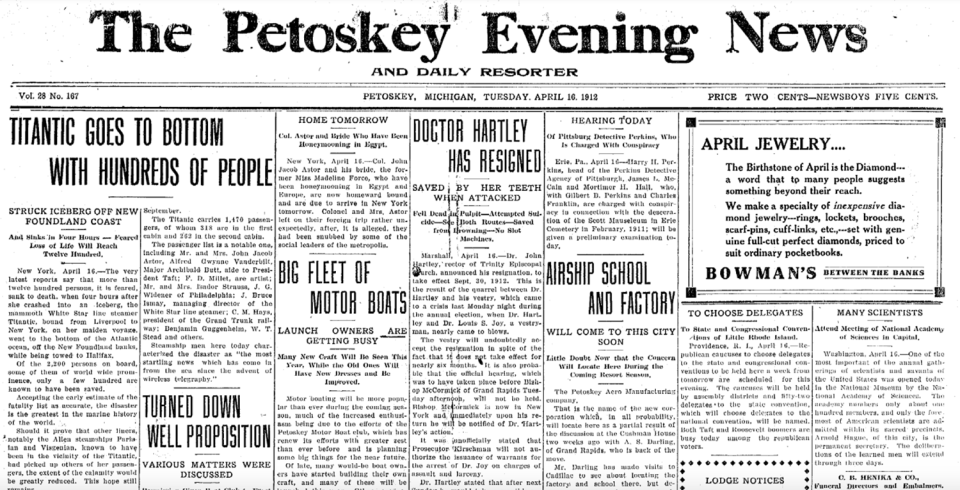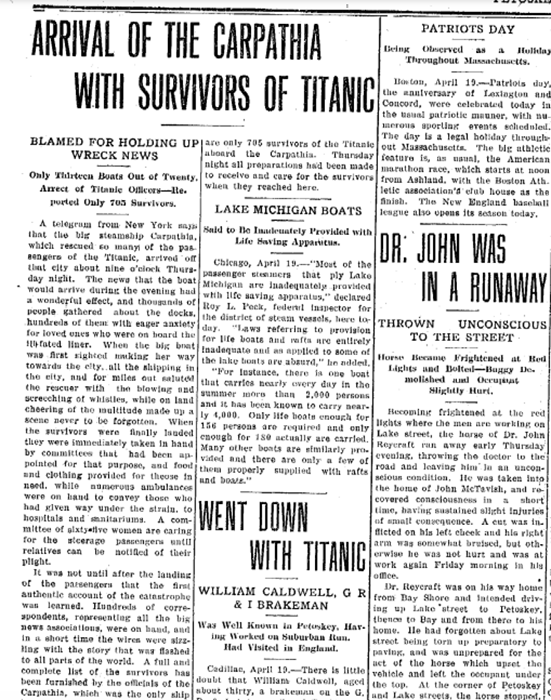As it happened: How local news reported the Titanic sinking
- Oops!Something went wrong.Please try again later.
When the Titanic launched from Southampton, England on April 10, 1912 on her maiden voyage, the ship was already the stuff of legend.
Famously, and ultimately ironically, dubbed “unsinkable,” the RMS Titanic was designed lavishly, with luxurious First Class accommodations and amenities such as gyms, pools, cafes, smoking rooms and more.
The ship, operated by the White Star Line, featured the height of new technology, such as radiotelegraph equipment and an electrical plant that was said to be capable of producing more power than an average city’s power station.
What happened on the Titanic’s crossing of the Atlantic Ocean cemented its tragic place in history.
At 11:40 p.m. on April 14, an iceberg was spotted directly ahead of the Titanic’s path. The ship struck the iceberg, critically damaging the hull. Less than three hours later, the Titanic was at the bottom of the ocean, taking around 1,500 lives with it.
Between the ship’s lofty reputation, its star studded passenger list and the sheer scale of the loss, the tragedy landed on the front page of newspapers around the world. However, the earliest reports were riddled with misinformation and inaccuracies. The survivors had not yet been returned to shore and rumors ran rampant with what little information was known.

In the April 16, 1912 edition of the Petoskey Evening News, it was reported that the Titanic sank while being towed to Halifax, which was untrue.
“The very latest reports say that more than twelve hundred persons, it is feared, sank to death, when four hours after she crashed into an iceberg, the mammoth White Star line steamer Titanic, bound from Liverpool to New York, on her maiden voyage, went to the bottom of the Atlantic Ocean, off the New Foundland banks, while being towed to Halifax,” the story reads.
“Of the 2,200 persons on board, some of them of world wide prominence, only a few hundred are known to have been saved.
“Accepting the early estimate of the fatality list as accurate, the disaster is the greatest in the marine history of the world.”
The Petoskey paper included a list of some of the more well known passengers, a veritable who’s who of the rich and famous of the early 20th century.
“The passenger list is a notable one, including Mr. and Mrs. John Jacob Astor, Alfred Gwynne Vanderbilt, Major Archibald Butt, aide to President Taft; F.D. Millet, artist; Mr. and Mrs. Isador Strauss, J.G. Widener of Philadelphia; J. Bruce Ismay, managing director of the White Star line steamer; C. M. Hays, president of the Grand Trunk railway; Benjamin Guggenheim, W.T. Stead and others.
“Steamship men here today characterized the disaster as ‘the most startling news which has come in from the sea since the event of wireless telegraphy.’”
Strangely, the Petoskey paper also ran a small item of celebrity gossip directly next to this list about Mr. and Mrs. John Jacob Astor.
“Col. John Jacob Astor and his bride, the former Miss Madeline Force, who have been honeymooning in Egypt and Europe, are now homeward bound and are due to arrive in New York tomorrow.”
This was also untrue. John Jacob Astor died in the sinking, while his wife survived.
Subscribe: Check out our offers and read the local news that matters to you

By April 19, news outlets had reported that the Carpathia had arrived in New York with the survivors, and people finally began to definitively learn who had lived and who had died.
For Northern Michigan residents, they grieved a 30-year-old railroad brakeman who was a former summer resident of Petoskey.
“There is little doubt that William Caldwell, aged about thirty, a brakeman on the G.R. & I. between Grand Rapids and Mackinaw City, was one of the ill-fated passengers of the steamship Titanic, which found a watery grave off the Newfoundland banks Monday morning after colliding with an iceberg,” read a story in the Evening News. “Every year Mr. Caldwell has made a trip to South Hampton, England, for a visit with his parents, and letters received in this city are to the effect that upon returning he would accompany the Titanic on its maiden voyage. As his name is not among those saved, it is believed he perished when the vessel foundered.”
But, just a few days later, Caldwell arrived safely home and was perplexed to find his death had been prematurely reported. He had never even been onboard the Titanic.
The April 23 story is titled “Reads about his own death.”
“William Caldwell, G.R. & I. brakeman, did not go down with the Titanic, as was believed, and he has arrived at his Grand Rapids home, shaking hands with himself and his friends over his fortunate escape, which was by the merest accident,” the story reads. “Because Caldwell wrote home from England that he intended sailing on the Titanic, and as no further word had been received from him, it was believed he had perished with the 1,601 unfortunate persons who were unable to escape from the liner. The circumstances which in all probability saved Caldwell’s life was the mistake of a steamship clerk at Liverpool, who secured him a berth on the Mauritania instead of the Titanic … Mr. Caldwell is one of those few individuals who are able to read about their own deaths and see what people think about them, for many newspapers reported his demise in the ocean as almost certain. The report was indeed well founded, but Caldwell refused to seek a watery grave just to satisfy the press.”
As the full extent of the disaster became known, questions about accountability and safety quickly found their way into newspapers.
In an April 19 report, a survey of Lake Michigan boats found them to be “inadequately provided with life saving apparatus.”
The story reads: “‘Most of the passenger steamers that ply Lake Michigan are inadequately provided with life saving apparatus,’ declared Roy L. Peck, federal inspector for the district of steam vessels, here today. ‘Laws referring to provision for life boats and rafts are entirely inadequate and as applied to some of the lake boats are absurd,’ he added.”
Along with its long cultural significance, the Titanic’s sinking left a legacy in improving marine safety across the world. New standards regarding lifeboats, radio communications and the formation of the International Ice Patrol all came about as a direct result of the tragic disaster.
— Contact Jillian Fellows at jfellows@petoskeynews.com.
This article originally appeared on The Petoskey News-Review: As it happened: How local news reported the Titanic sinking

